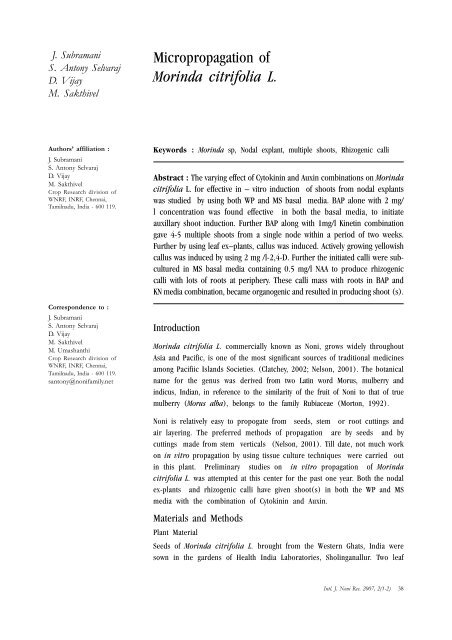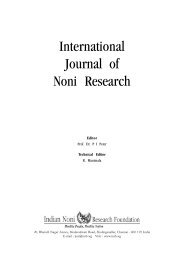International Journal of Noni Research - Noni Family
International Journal of Noni Research - Noni Family
International Journal of Noni Research - Noni Family
Create successful ePaper yourself
Turn your PDF publications into a flip-book with our unique Google optimized e-Paper software.
J. Subramani<br />
S. Antony Selvaraj<br />
D. Vijay<br />
M. Sakthivel<br />
Authors’ affiliation :<br />
J. Subramani<br />
S. Antony Selvaraj<br />
D. Vijay<br />
M. Sakthivel<br />
Crop <strong>Research</strong> division <strong>of</strong><br />
WNRF, INRF, Chennai,<br />
Tamilnadu, India - 600 119.<br />
Correspondence to :<br />
J. Subramani<br />
S. Antony Selvaraj<br />
D. Vijay<br />
M. Sakthivel<br />
M. Umashanthi<br />
Crop <strong>Research</strong> division <strong>of</strong><br />
WNRF, INRF, Chennai,<br />
Tamilnadu, India - 600 119.<br />
santony@nonifamily.net<br />
Micropropagation <strong>of</strong><br />
Morinda citrifolia L.<br />
Keywords : Morinda sp, Nodal explant, multiple shoots, Rhizogenic calli<br />
Abstract : The varying effect <strong>of</strong> Cytokinin and Auxin combinations on Morinda<br />
citrifolia L. for effective in – vitro induction <strong>of</strong> shoots from nodal explants<br />
was studied by using both WP and MS basal media. BAP alone with 2 mg/<br />
l concentration was found effective in both the basal media, to initiate<br />
auxillary shoot induction. Further BAP along with 1mg/l Kinetin combination<br />
gave 4-5 multiple shoots from a single node within a period <strong>of</strong> two weeks.<br />
Further by using leaf ex–plants, callus was induced. Actively growing yellowish<br />
callus was induced by using 2 mg /l-2,4-D. Further the initiated calli were subcultured<br />
in MS basal media containing 0.5 mg/l NAA to produce rhizogenic<br />
calli with lots <strong>of</strong> roots at periphery. These calli mass with roots in BAP and<br />
KN media combination, became organogenic and resulted in producing shoot (s).<br />
Introduction<br />
Morinda citrifolia L. commercially known as <strong>Noni</strong>, grows widely throughout<br />
Asia and Pacific, is one <strong>of</strong> the most significant sources <strong>of</strong> traditional medicines<br />
among Pacifiic Islands Societies. (Clatchey, 2002; Nelson, 2001). The botanical<br />
name for the genus was derived from two Latin word Morus, mulberry and<br />
indicus, Indian, in reference to the similarity <strong>of</strong> the fruit <strong>of</strong> <strong>Noni</strong> to that <strong>of</strong> true<br />
mulberry (Morus alba), belongs to the family Rubiaceae (Morton, 1992).<br />
<strong>Noni</strong> is relatively easy to propogate from seeds, stem or root cuttings and<br />
air layering. The preferred methods <strong>of</strong> propagation are by seeds and by<br />
cuttings made from stem verticals (Nelson, 2001). Till date, not much work<br />
on in vitro propagation by using tissue culture techniques were carried out<br />
in this plant. Preliminary studies on in vitro propagation <strong>of</strong> Morinda<br />
citrifolia L. was attempted at this center for the past one year. Both the nodal<br />
ex-plants and rhizogenic calli have given shoot(s) in both the WP and MS<br />
media with the combination <strong>of</strong> Cytokinin and Auxin.<br />
Materials and Methods<br />
Plant Material<br />
Seeds <strong>of</strong> Morinda citrifolia L. brought from the Western Ghats, India were<br />
sown in the gardens <strong>of</strong> Health India Laboratories, Sholinganallur. Two leaf<br />
Intl. J. <strong>Noni</strong> Res. 2007, 2(1-2) 38








